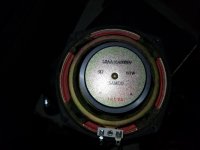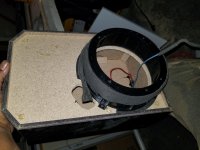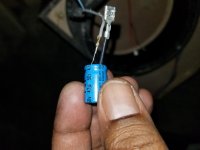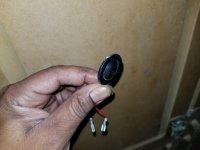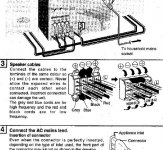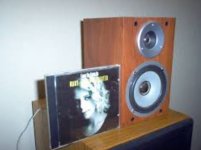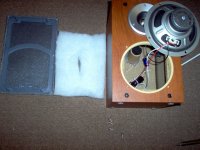Hello all, I am attempting to build new enclosures for a Panasonic SB Ak320 shelf system I acquired. The original system used the bi-amplification method to each 3-way set of speakers. I will save my query of how to get the correct dimensions for these speakers for another thread, however, I am here to ask is there a pre made 3 way crossover I can use on these speakers once I have built the proper enclosure? Below is the info I found via Chet regarding amplification output.
AMPLIFIER OUTPUT DETAILS
Output Power / Channel
75 Watt
Output Impedance / Channel
6 Ohm
Frequency Response
at 1 kHz, at 10 kHz
Total Harmonic Distortion (THD)
10 %
Channel Type
main - midrange/tweeter, main - woofer
Channel Qty
2
Thanks in advance and I'm willing to build the crossover if one is not available.
AMPLIFIER OUTPUT DETAILS
Output Power / Channel
75 Watt
Output Impedance / Channel
6 Ohm
Frequency Response
at 1 kHz, at 10 kHz
Total Harmonic Distortion (THD)
10 %
Channel Type
main - midrange/tweeter, main - woofer
Channel Qty
2
Thanks in advance and I'm willing to build the crossover if one is not available.
Hi Jay,
WHat you need are the parameters of the woofer, for now the other stuff doesn't matter. Once you have those values (T/S parameters), you can design the box for the woofer.
Next, is the midrange a sealed back? If not, you need a small box for it also. You also need the resonant frequency and the total "Q" for the midrange. Follow the same procedure that you did for the woofers. Add whatever space the box or just the driver will take up in the box to compensate for them being there.
The tweeter is very probably a sealed design. It won't take up any room inside the box. You do however want to find out it's resonant frequency and the total "Q" of the driver.
So now you have enough information to build the box properly. It will likely be 2X the size of the box it came out of, maybe more. Next, the crossover.
Crossovers not only split the frequencies up, they also correct for efficiencies and anomalies in the speaker response (or not if you wish). These aren't expensive speakers, so don't go nuts here. A couple guidelines. You want to make the crossover frequency 2X or more than the resonant frequency of the driver (mid or tweeter). If your midrange resonates at 450 Hz, you don't want to cross into it until at least 900Hz. Similarly for the tweeter, if resonance is 2.6 KHz, you don't want to cross over to it until 5.3 KHz. These numbers are pessimistic in case you are wondering. Sometimes you have to make your crossover frequencies lower than you would want to. This is life.
Zobel networks. These are series R-C networks placed across midrange and woofer drivers to correct for their rising impedance with frequency. That way the crossover crosses over when they should and not allow higher frequencies through.
This is a quick guide because what you are asking has a few steps to it. Box sizes are a a science that can be calculated, then allowances made for the physical construction and added things like braces and stuffing. If you have a ported box, you must add the volume taken by the port as well. You would be surprised how much volume is taken up by something like bracing.
Or, you could just wack a box together larger than the original and it might sound better. The crossover will require work from you though.
-Chris
WHat you need are the parameters of the woofer, for now the other stuff doesn't matter. Once you have those values (T/S parameters), you can design the box for the woofer.
Next, is the midrange a sealed back? If not, you need a small box for it also. You also need the resonant frequency and the total "Q" for the midrange. Follow the same procedure that you did for the woofers. Add whatever space the box or just the driver will take up in the box to compensate for them being there.
The tweeter is very probably a sealed design. It won't take up any room inside the box. You do however want to find out it's resonant frequency and the total "Q" of the driver.
So now you have enough information to build the box properly. It will likely be 2X the size of the box it came out of, maybe more. Next, the crossover.
Crossovers not only split the frequencies up, they also correct for efficiencies and anomalies in the speaker response (or not if you wish). These aren't expensive speakers, so don't go nuts here. A couple guidelines. You want to make the crossover frequency 2X or more than the resonant frequency of the driver (mid or tweeter). If your midrange resonates at 450 Hz, you don't want to cross into it until at least 900Hz. Similarly for the tweeter, if resonance is 2.6 KHz, you don't want to cross over to it until 5.3 KHz. These numbers are pessimistic in case you are wondering. Sometimes you have to make your crossover frequencies lower than you would want to. This is life.
Zobel networks. These are series R-C networks placed across midrange and woofer drivers to correct for their rising impedance with frequency. That way the crossover crosses over when they should and not allow higher frequencies through.
This is a quick guide because what you are asking has a few steps to it. Box sizes are a a science that can be calculated, then allowances made for the physical construction and added things like braces and stuffing. If you have a ported box, you must add the volume taken by the port as well. You would be surprised how much volume is taken up by something like bracing.
Or, you could just wack a box together larger than the original and it might sound better. The crossover will require work from you though.
-Chris
Thanks Anatech, however where do I get the information for the parameters you mentioned, the specs for the system do not give those detailed parameters, Also the mid range drivers are not sealed backs. I have attached pictures of all the extracted drivers and the original enclosure. Also, after a closer examination and with regard to crossover issue, I took a pic of the cap that was used in line with the wiring to the mid/tweet drivers. Like like a 4.7uf 50v cap
Attachments
I can't make head nor tail of those pictures, my friend. 😀
Presumably this is a three way speaker. I'm guessing the mid and tweeter are wired into a sort of supermid with the 4.7uF to the tweeter.
The bass probably works on a separate channel. If I'm guessing right, the amp has an electronic bass mid filter.
I have seen this sort of thing before from Panasonic. See below.
TBH, this is a piece of cheap consumer junk. I wouldn't waste time trying to rebuild it with an off-the-shelf crossover. We really have no idea what the drivers are, and if experience is a guide, you don't know enough to even attempt it. Sorry.
Presumably this is a three way speaker. I'm guessing the mid and tweeter are wired into a sort of supermid with the 4.7uF to the tweeter.
The bass probably works on a separate channel. If I'm guessing right, the amp has an electronic bass mid filter.
I have seen this sort of thing before from Panasonic. See below.
TBH, this is a piece of cheap consumer junk. I wouldn't waste time trying to rebuild it with an off-the-shelf crossover. We really have no idea what the drivers are, and if experience is a guide, you don't know enough to even attempt it. Sorry.
Attachments
There you have a basically 2 way speaker drivers, a midwoofer, a cone tweeter and a piezo supertweeter. Use the first two for a 2 way design. I did the same with some Aiwa's of mine, post #8.
What have you built lately?
What have you built lately?
Ah, that makes sense. The piezo will be wired in parallel across the cone tweeter, and the 4.7uF connects to both. The bass is unfiltered. So it's a two way with supertweeter, in effect. Piezos used to be used in boomboxes with about 4" radio speakers for a bit of tizz at the top end
Relies on a "bi-amplification" electronic filter from the amp quite likely. But still very Mickey Mouse however it works.
I have some similar tiny music centre speakers lying about. A coil on the bass, and a cap on the tweeter. Sound dreadful. Nothing there I could use. 😀
Relies on a "bi-amplification" electronic filter from the amp quite likely. But still very Mickey Mouse however it works.
I have some similar tiny music centre speakers lying about. A coil on the bass, and a cap on the tweeter. Sound dreadful. Nothing there I could use. 😀
Attachments
I no longer have the head unit, just the drivers, that's why I'm trying to rebuild the driver enclosures and put the correct crossover on them, I just calculated the midwoofers original cabinet volume at approx. 7.835liters so that's a start I guess. Could I simply use the same type of cap (4.7uf/50v) on the tweeter? But where or where is the midwoofer crossed over since that was done by the headunit?
Why not rebuild? I mean, use what you've got. We're all used to SEAS this, Faital that, Monacor the other - you know, the really expensive stuff, with super non-resonant exotic cabinets stuffed with a material that costs more than a consumer hi-fi set.
That said, measure the drivers. I agree - use the tweeter and mid and leave the piezo alone. Measure the resonance of both - this can easily be done by connecting a 10 ohm (at least 5W) resistor in series with the driver, and for the mid, sweep frequencies from about 30 Hz up. Measure the voltage on the resistor and find where it dips the lowest. This is the resonance frequency. Do the same for the tweeter, but sweep from about 1kHz up.
Resonance on the mid can help you get a bit of an idea of what bass you can sort of expect from it, and resonance on your tweeter can help you decide on a crossover point. Essentially, if you're going to measure anything, let it be the tweeter resonance.
There is a lot to find online about how to measure the parameters of the mid, but honestly, it's a tedious mission. Lojzek (I think) suggested a method once to me, but I never got around to using it because I never got round to using what I was measuring. If you do measure TS parameters, you can build a calculated box.
In my opinion, measure the DC resistance of the tweeter and the mid, then design the crossover for at least 1.3 x tweeter resonance (this is arbitrary, but useful). Here's a good page on crossover design: Introduction to designing crossovers without measurement
Where it talks about leveling the impedance with an RC, just ignore it and don't do it - it uses the inductance of the driver, which you don't know.
Then build a small sealed box - however you want to. Decide the dimensions, and don't worry about the volume. Once you've done this, you can always add a port, which you can also make fairly arbitrary, but there are calculators online to help you find the length of the port. I'd say measure your box's volume, and then calculate a port tuning of about 60 - 70 Hz (but you don't need to add a port).
Now, you're not going to end up with something to make the Audiophile's mouth drop open (probably), so why do this? Because it's fun. 🙂
That said, measure the drivers. I agree - use the tweeter and mid and leave the piezo alone. Measure the resonance of both - this can easily be done by connecting a 10 ohm (at least 5W) resistor in series with the driver, and for the mid, sweep frequencies from about 30 Hz up. Measure the voltage on the resistor and find where it dips the lowest. This is the resonance frequency. Do the same for the tweeter, but sweep from about 1kHz up.
Resonance on the mid can help you get a bit of an idea of what bass you can sort of expect from it, and resonance on your tweeter can help you decide on a crossover point. Essentially, if you're going to measure anything, let it be the tweeter resonance.
There is a lot to find online about how to measure the parameters of the mid, but honestly, it's a tedious mission. Lojzek (I think) suggested a method once to me, but I never got around to using it because I never got round to using what I was measuring. If you do measure TS parameters, you can build a calculated box.
In my opinion, measure the DC resistance of the tweeter and the mid, then design the crossover for at least 1.3 x tweeter resonance (this is arbitrary, but useful). Here's a good page on crossover design: Introduction to designing crossovers without measurement
Where it talks about leveling the impedance with an RC, just ignore it and don't do it - it uses the inductance of the driver, which you don't know.
Then build a small sealed box - however you want to. Decide the dimensions, and don't worry about the volume. Once you've done this, you can always add a port, which you can also make fairly arbitrary, but there are calculators online to help you find the length of the port. I'd say measure your box's volume, and then calculate a port tuning of about 60 - 70 Hz (but you don't need to add a port).
Now, you're not going to end up with something to make the Audiophile's mouth drop open (probably), so why do this? Because it's fun. 🙂
THANKS mrcloc, i will attempt to measure today after i get the voltage meter. I also appreciate the encouragement to "DIY", waste not want not and i hate to see working drivers go to waste. However, I'm slightly confused when u mention building a sealed box without the proper volume??Then you mention calculating the port tuning but " don't need to add a port" ?? And yes it's fun plus my.mother in law is requesting a system of her own after hearing my Mikizou and Paul camody.s sub design combo. I know this project wil not sound as good but she is not an audiophile lol
- Status
- Not open for further replies.
- Home
- Loudspeakers
- Multi-Way
- Replacing crossover in Panasonic SB ak320
